
The Main Elements of the Business Processes
Running a successful business means maximizing efficiency across a range of complex procedures. Sometimes, that involves outsourcing and plenty of it. According to the latest data, the Business Process Outsourcing Market was a USD 187.91 billion industry in 2018 and is projected to grow to an astounding USD 314.81 billion by 2025.
There are some principal activities that occupy business owners from large to small. The activities can be broken down into three categories: core business, critical activities, and non-core activities.
“The real power of outsourcing going forward is going to be that it increases an organization’s core capacity for change and growth.” - Michael Corbett, Chairman, International Association of Outsourcing Professionals (IAOP)
Categorizing business activities is essential to ensuring that resources, both capital, and human, are appropriately dedicated to achieving maximum profit and operational effectiveness. It's helpful to define these activities as beginning the process of classification.
Examples of BPO services:
As the trend towards BPO continues to develop, almost every business outsources some aspect of their business process. The BPO industry has been responsible for providing cost-effective services to many businesses. The range of business domains to which the BPO industry can be of service includes:
Core Activities
Core activities include everything that leads to the achievement of the business goal and contributes to gaining strategic advantage. These activities are must-do. A business owner should be allocating a significant percentage of resources to these activities.
When the core activities are identified that are not currently being carried out and that will lead to the stated goals of the business, it is essential to investigate how organizational capacity can grow to accommodate those newly identified activities. Core activities are the key, defining activities of an organization. If they are given to an external party, the result would be a new competitor or dissolution.
Critical Activities
Critical activities but non-core activities, meanwhile, must be performed at a high level of competency, but they do not constitute the core business goal. Logistics, for example, is an oft-cited example of critical but non-core activities. Failure to harness the potential of these businesses to differentiate one's business from the competitor can lead to a massive loss of market share.
Consider, the example of Coca Cola's distribution network. It is not the core business goal of the company, and yet having mastered the art of effective and efficient global distribution, they achieve deeper market penetration than their competitors.
Non-core Activities
These are not contributing to the business goal. Also, they are not supporting the relationship between your product or service and the consumer. They are activities that should undoubtedly be divested or outsourced.
It can be challenging to identify these activities because, of course, there are so many activities that go into successfully growing a business; however, rededicating your resources away from non-core activities frees up time, money, and talent to be devoted to core operations.
The following question can identify non-core activities: If we didn't conduct this activity for a week, would the company continue to exist and produce? If the answer is yes, then the action needs to be intelligently divested.
As companies redouble their efforts on core business operations and hone in on developing a competitive advantage, non-core functions are increasingly outsourced. Companies struggle to manage non-core, non-strategic processes, such as distribution and inventory management, accounting and HR, credit card processing, and product testing.
Although these processes are vital to the day-to-day operation of many businesses, they are increasingly seen as overhead functions that are not essential to the definition of the core business and, as such, are not contributing to market share or profit.
Which Activities are Outsourceable?
The critical question that a company must ask is, “what functions are outsourceable and what is the business benefit tare realized by doing so." It is essential to a plan of activities that the company will not engage in. This action demonstrates the efficient use of time and resources. Business leaders often overlook the importance of choosing where not to focus attention and effort.
As companies are increasingly deciding which functions and processes are essential to their core business and which is delegated, a range of alternative options is emerging to take on non-core activities. Digital penetration and mobile productivity applications have made it so that outsourcing these activities to specialists is both efficient and convenient.
The total number of processes that companies consider core is shrinking, while the proportion of non-core yet critical processes will continue to expand.
“Do what you do best, and outsource the rest.” Peter Drucker – Management consultant, educator, and author.
Enterprises prepared to meet the opportunity to allocate resources to their core business by delegating non-core activities will see gains in customer service, efficiency, and costs. These processes should transition to an outsourcer without disruption of duty or compromise quality or confidentiality.
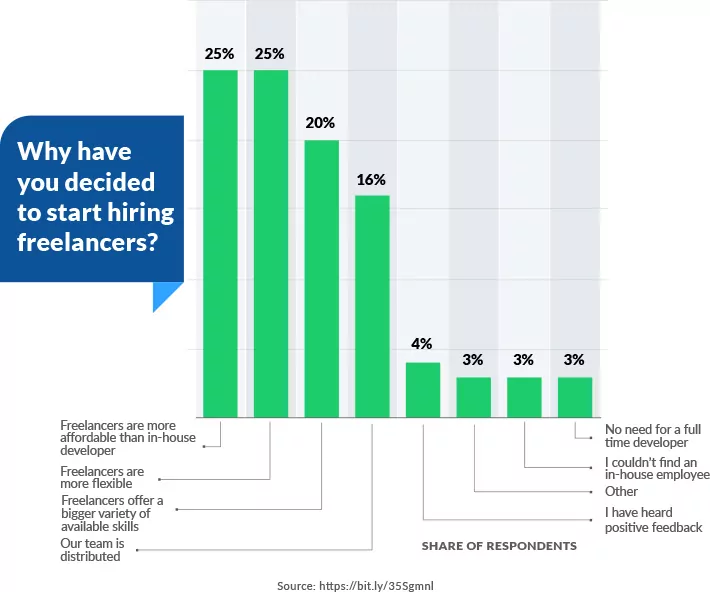
Business Process Outsourcing ("BPO") is one of the several areas in which a company can outsource their activities. It is a broad umbrella term designed to encompass non-core business activities to an external service provider.
These activities include legal services, payroll, IT, logistics, and more. Both large multinationals and SMB’s outsource these kinds of activities to service providers who handle everything from the back office to customer-facing processes.
BPO services can cover administration and business operations and can encompass hardware, software, and elements of staffing as well. BPO can change the operating model of a company by moving non-core activities away from in-house staff. In this way, economies of scale are realized, access is gained to more sophisticated technology, and focus redirected to essential, core, and revenue-generating business activities .
What is BPO as a concept?
A subset of the catch-all term outsourcing, Business Process Outsourcing (BPO), involves contracting a third-party to handle non-essential business activities. When BPO companies recruited internationally, the contract referred to offshore outsourcing. Contracting BPO companies within the same country where the client is located, the contact is seen as onshore outsourcing. Nearshore outsourcing relates to the situation where BPO is conducted within the same region but in a different country.
BPO services have been classified as either front-end or back-end. The industry also organizes them. For example, the BPO can look different for a retail business versus a healthcare-oriented business. BPO services run the gamut from customer service to HR, accounting, and more. Some of the most common processes that companies choose to outsource are information-technology based.
Industry-wide, BPO offerings consist of two primary categories:
- Horizontal offerings whereby the services leveraged across industries - for example, accounting. Horizontal BPO services typically provide traditional back-office services.
- Vertical-specific offerings require specific industry knowledge. In the latter case, the provider needs to be highly specialized. These industry-specific BPOs are proliferating and handle such specialized processes as claims and mortgage processing.
Examples of BPO services:
As the trend towards BPO continues to develop, almost every business outsources some aspect of their business process. The BPO industry has been responsible for providing cost-effective services to many businesses. The range of business domains to which the BPO industry can be of service includes:
- IT/ITES: Software development, IT staffing, Helpdesk services, Infrastructure Management Services
- Financial Services: Bookkeeping, Payroll Processing, Financial Analysis Services
- Healthcare Services: Teleradiology Services, Medical Transcription Services, Healthcare Claims Adjudication
- Call Center Services: Inbound and outbound call centers, telemarketing, email support, technical support services, etc.
- E-commerce Websites: Online ordering, Refund Processing
- Travel Industry: Bookings, Cancellations
- Retail Services: Ordering, Status checking
- Educational Institutions: Course information, Fees Processing
- Manufacturing: Component information, Ordering, Help services
- Telecom sector: Service information, Complaint Processing
Business Process Outsourcing History
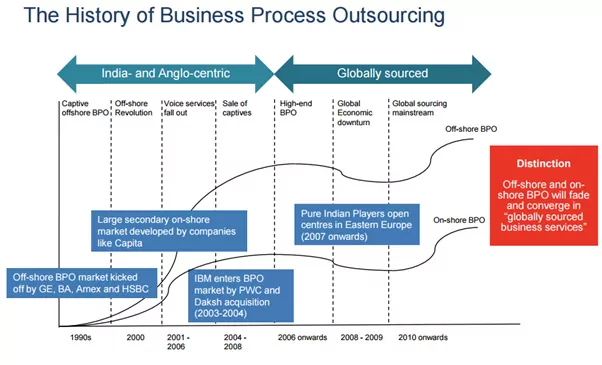
Differences Between Back Office Outsourcing and Front Office Outsourcing
BPO can be classified as either back office or front office. The main difference between the two is the extent to which the task is customer-facing.
What is the Front Office (Customer-Related Services)?
The front office consists of tasks whereby the customer is in direct contact with the BPO service provider. For example, a real estate company has a front office staff that helps convert leads to property buyers.
In a telecommunications company, front-facing staff work in retail environments to bring customers into contact with the product or service on offer—front-facing staff deal with customers daily in a sales and customer experience capacity. Contact centers were the first-way front office; customer relationships management activities were outsourced at scale.
A contact center system provides digital call and contact routing for high-volume telephone transactions, with specialized "agent" stations to answer calls while relying on a nuanced real-time contact management system. Contact center systems allow businesses to handle inbound contact and distribute efficiently.
The strategic result is the intelligent management of inbound telephone traffic. Increasingly, contact centers can now manage multiple types of incoming communication: text, emails, webform submissions, and more.
Since contact centers are software systems, they can operate in some ways: as an on-site service managed by the provider, as a hosted service managed off-site, or as is increasingly popular as “software as a service,” or cloud-based solution. The contact center system allows a business to systematically generate reports to review incoming contact activity, monitor activity in real-time, manage agents’ status, and more .
Customer care services, of which contact centers are a part, are experiencing tremendous global growth, with activity in 2018 measuring USD 18.11 billion. This is predicted to exceed USD 30.4 billion by 2027, growing at a CAGR of 6.2% from 2019 to 2027 .
What is the Back Office (Internal Business Functions)?
Back office functions, meanwhile, do not have a customer-facing element. They can be thought of as the plumbing in a building. They are essential to keep a business running smoothly; however, they are not customer facing and do not make up the core of the company’s business.
Back office includes activities that do not directly encounter customers nor generate revenue for the company. All administrative, clerical, and support functions are back-office: managing payroll, HR department, accounting, IT, data entry, administration, legal.
In recent years, there has been a growth in outsourcing these functions to other specialist companies rather than having people in-house to do it. There are reasons for this growth with advantages and disadvantages in deciding whether to outsource.
Outsourcing back-office processes is a well-established global business practice. According to Grant Thornton, two out of every five businesses outsource back-office processes as a means of reducing costs, improving efficiencies, and, in many cases, ensuring compliance .
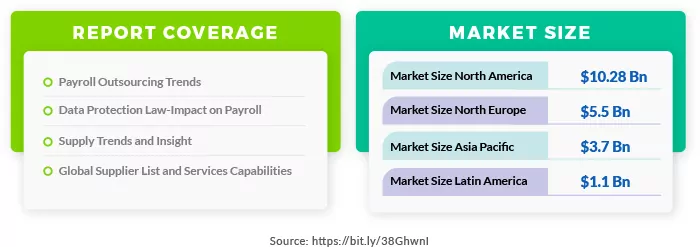
Payroll and HR are most often outsourced with a market size of USD 10.28 billion in North America and 5.5 billion in Europe Given that most companies’ priority in outsourcing is to increase efficiency and lower costs, HR and Payroll, heavily transactional processes, are an easy entry point to explore the potential of BPO.
Common BPO Subsets
BPO has spawned subsets: Knowledge Process Outsourcing (KPO), Creative Process Outsourcing (CPO), Legal Process Outsourcing (LPO), Information Technology Outsourcing (ITO), Robotic Process Outsourcing (RPO), Human Resource Outsourcing (HRO). These subsets categorize and organize a wide range of highly specialized services that can potentially be outsourced to third-party service providers.
CPO
Creative Process Outsourcing (CPO) allows a company to divest its marketing and advertising needs to a third party. Through these B2B relationships, the work is of a higher quality and completed at a lower cost. Depending on the specifics of the project, program, or product, some companies outsource the more mechanical or technical aspects of their creative work while keeping the creative direction in-house.
Outsourcing of tasks that a company does not specialize in, such as graphic design, photo-editing, and video creation, is also common. It is not unusual for large multinationals to outsource their entire creative workflow to augment and complement in-house marketing teams .
KPO
Meanwhile, knowledge process outsourcing (KPO) allows a business to contract relatively high-level tasks to specialists in a given field. For example, KPO involves sending long-term jobs out of the house to the intellectual, analytical, and knowledgeable people within industries such as research and development, financial consultancy and services, business, and technical analysis.
KPO may not necessarily lead to cost savings, but certainly adds value. The services provided under the rubric of KPO are highly specialized and often technical and require statistical, analytical, and research expertise .
LPO
Legal process outsourcing (LPO) is a subset of KPO. LPO services include a comprehensive menu of offerings: patents, legal research, pre-litigation documentation, advising, licensing agreements, and drafting distribution agreements.
Law services have already begun to move offshore, with thousands of jobs every year moving from the US to India. Indian law is based on English common law making it a natural place to attract the US and UK businesses.
RPO
RPO stands for Recruitment Process Outsourcing and deals primarily with human resources - and in particular recruitment. Research process outsourcing (also RPO) is relevant to the biotech industry, where clients outsource their research and development work to medical researchers.
HRO
HRO stands for Human Resource Outsourcing. Outsourcing HR allows a company to take advantage of knowledgeable HR professionals who have expertise in contracting, salary, promotion, employee rights, evaluation, and professional development. HR is comprised of more than just hiring.
The HR process includes payroll management, training, staffing, benefits administration, travel, expenses management, retirement, benefits planning, risk management, compensation consulting, etc. In the US context, HR represents the primary and most prominent example of BPO. Between 29-30 percent of the BPO market is comprised of HR outsourcing .
ITO
Information technology outsourcing (ITO) refers to outsourcing software management, internet services, network management, servers, and digital protocols. ITO can involve everything from database management, website building, server, and network management to mobile technology policy.
Market Demand for BPO
In terms of outsourcing, BPO is among the fastest-growing sectors. Price sensitivity is driving the industry and provoking growth. However, businesses also realize efficiency gains, lower risk, shorten the product development cycle, and foster innovation. Concrete benefits include:
- Lower Operating Costs
- Improved Automation
- More Flexibility In Scaling
- Access To Experts And Technology
- Smarter Analytics About Both Consumers and Products
Having outsourced most time-consuming and labor-intensive day-to-day tasks, companies can focus on the key aspects of connecting with customers and building brand loyalty. That’s where the true benefits of BPO lie – in allowing brands to focus on growth and adaptation.
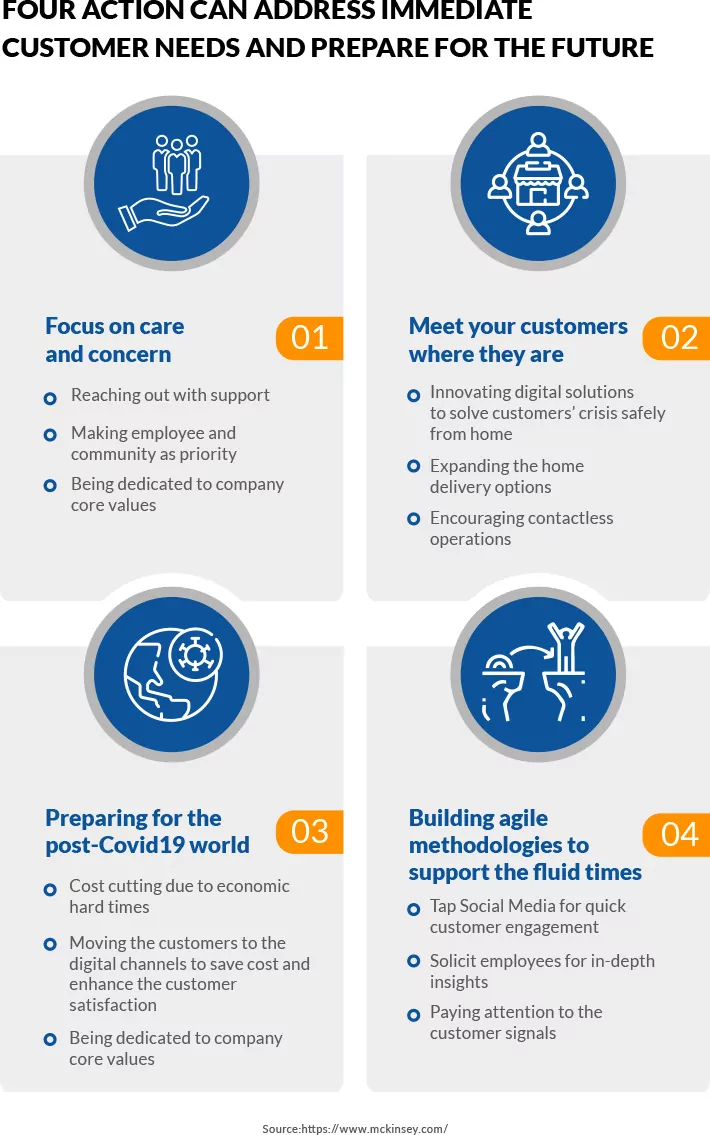
Outsourcing, increasingly a common business strategy, can result in a significant competitive advantage.
According to a TechNavio report , the market is segmented, with several major players, but the overall market demand is increasing, in part due to the COVID-19 pandemic. Here are some of the main takeaways:
- A Market Growth Increase in 2020 at near 10% CAGR
- COVID-19 will not noticeably impact the BPO market
- The IT sector, in general, will have a mixed impact due to COVID-19 but is expected to maintain a steady growth rate
- The driver of growth will have an increased focus on automation
- 41% of the development will come from North America
- The incremental growth from 2020 to 2024 will be USD 105.59 billion
- The market is expected to normalize at the earliest by Q-3 2021, and at latest by Q-3 2022
Key Factors in the Growth of BPO
In the last two decades, developing nations that have made investments in infrastructure and education are set to reap the advantages of the global movement of BPO. For the BPO sector, a confluence of factors has led to significant growth: a large pool of educated, English-speaking labor, paired with high-speed wireless network penetration has meant that working across borders, space and time has never been easier or more cost-effective.
Economies of scale have also contributed to the profit potential for the BPO sector. The BPO sector has capitalized on the wage differential between the Global South and North so that companies in the North and West can take advantage of lower costs.
BPO conforms to the comparative advantage theory, which states that countries benefit by exporting goods and services when cheaper to be made in the home country and benefit by importing goods and services from countries where they are affordable.
Finally, the BPO phenomenon has also been driven by demographics. As populations in the Global north and west age, and as populations in the south and east are younger, a massive pool of skilled workers represents the enormous potential for the growth of BPO. Price sensitivity as a result of the 2008 recession has led to the development of the BPO sector amongst this skilled workforce .
Demand for an Outstanding Customer Experience
Contact center options with a positive return on investment (ROI) have come a long way over the years with the introduction of speech analytics, speech self-service, and, on the horizon, the use of artificial intelligence (AI) and robotics.
However, contact center leaders continue to recognize the value of trained and experienced analysts who possess the knowledge and the empathy to ensure the interaction with the customer meets expectations in a timely, thorough, and successful manner .
Advantages of BPO
Talking to BPO clients, the main reasons they chose to outsource their business process are sensible business-wise. In 2019, the main criteria for a business selected a service provider was increased efficiency, increased available expertise, and increased flexibility .
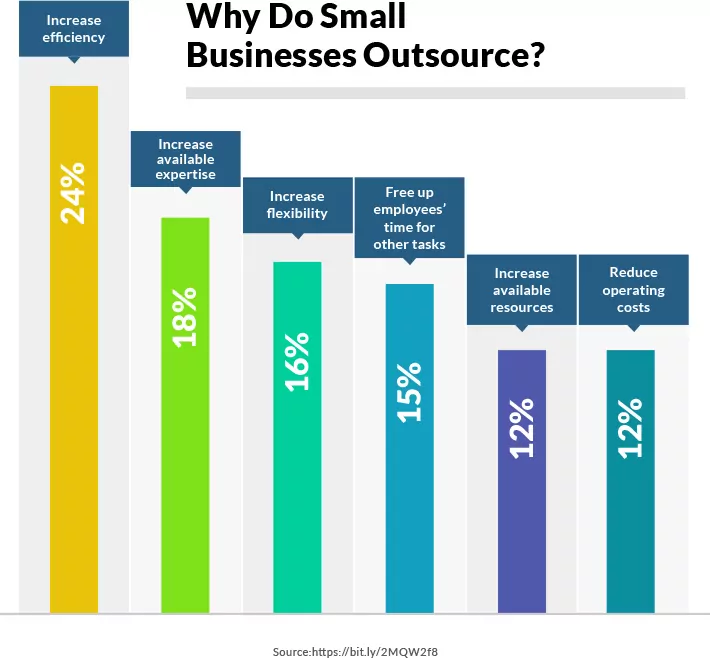
There are many potential advantages for the contraction of the BPO sector for business needs. Cost reduction concerning labor is among the most oft-cited reasons for exploring BPO. A BPO company can maximize efficiency and pass the savings on to their clients.
BPO also frees up capital by eliminating overhead both human capital-related and equipment related. The need for office and warehouse space can also be eliminated, and the costs of the BPO offset by these savings. A company that contracts BPO services also benefits their business by making more space and time to focus on core business processes.
Quality and efficiency can be significantly improved with BPO. BPO’s make your non-core activities their core activities. As such, they are always working to improve their processes and output. They are experts in their field. The result is a higher level of process expertise than the outsourcing company has time or resources to achieve.
BPO’s will invest in state-of-the-art process and technology that your business could not afford. This allows your business access to innovations and continuous improvements in your non-core activities.
When you rely on the BPO sector, you can innovate and prototype more rapidly and be nimble. Recruiting, training, and retaining staff requires a great deal of effort and constrains the business decisions that managers can make.
BPO allows a business to scale up and down as necessary. Customer service can also benefit from contracting BPO. Support can be provided multilingually and without investing in training or facility spaces, equipment, or software.
Shifting non-core processes to an outsourcing provider can help your company avoid risks. Instead of investing large amounts of capital in facilities, equipment, and staff, now you can invest in outcome-based contracts that can be evaluated and tweaked to improve outcomes.
There is far less risk in product testing as it is easier to ramp up or wind down production when dealing with BPO providers. Risk can also be hedged by crafting contracts carefully that allow for a degree of certainty and accountability about costs and quality .
BPO’s are increasingly a must-have resource for a business’s compliance strategy. As organizations are increasingly operating globally, compliance can become complex and difficult to navigate. BPO services can also support a business in engineering more efficient internal processes. Performing as a consultant, a BPO service can help your business build a much better working way .
Limitations and Risks
There is no business strategy that is entirely risk-free. BPO is no different.
Some of the risks facing the BPO industry and its users include the threat of a shrinking talent pool as global demographic trends; rising costs of labor in emerging markets; increasing reliance on robotics technology; the proliferation of smart devices which constitute the internet of things and reduce the need for human intervention, etc .
The BPO industry continues to evolve, and the increased demand is being met by a shortage of highly skilled labor to address rising demand. Increasingly, specialized skills in combination with each other - German and computer science, mathematics, and accounting .
Automation is increasingly being explored by the service providers. More than cost savings, automation could represent an opportunity for significant efficiency increases. Over the next two to three years, service providers expect that the traditional BPO engagement model will be transformed by robotics and greater automation levels .
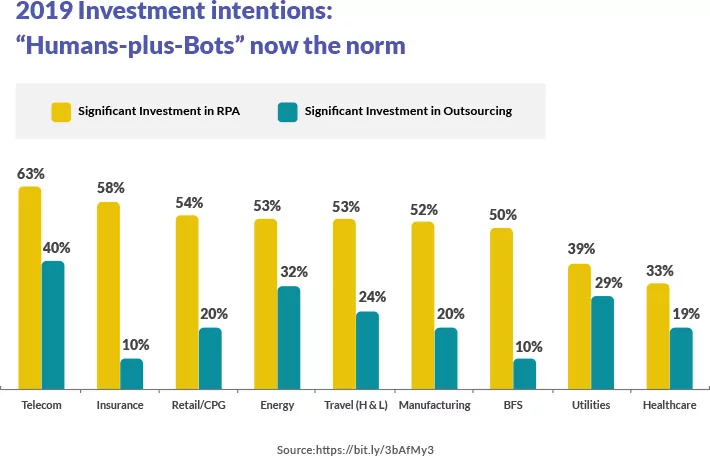
BPO and Client-Side Risk
Clients of BPOs have to be aware of the risks of outsourcing any part of their business. Most important is that the BPO service provider is compliant with all regulations, copyrights, and procedures so as not to put their clients at risk. While businesses are increasingly savvy about managing the risk involved with BPO, data security, privacy, and governance are still exposing clients to risk .
The US Federal Reserve has recently warned financial institutions of several risks of using BPO. Chief among them are risks related to compliance. It is imperative that the BPO service provider be well-versed in their client's applicable laws and regulations. The client must make sure that the BPO is operating with the client’s reputation in mind. It takes just a few customer service failures or logistics to do significant damage to a company’s position in the market.
Other risks to consider are those posed by cultural differences concerning communication protocols and work ethics. Information sharing may be treated with a different kind of ethic or level of sensitivity. Businesses must be sure of the contracts' enforceability and legality with which they enter into a professional relationship with a BPO provider. Finally, companies must be sure that the BPO provider is prepared to mitigate against the partial or complete interruption of critical functionality .
Being wary of certain risks and guided by the experience, industry leaders surveyed by Deloitte did the following to mitigate BPO risks in the future:
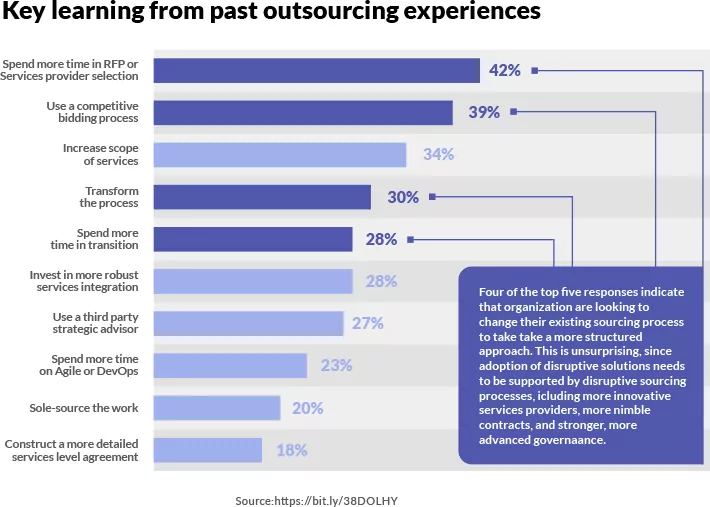
Many of the concerns seem to stem from cloud service and RPA contracting, the most common risks being cited for both being data security, performance and resilience, and compliance with laws and regulations.
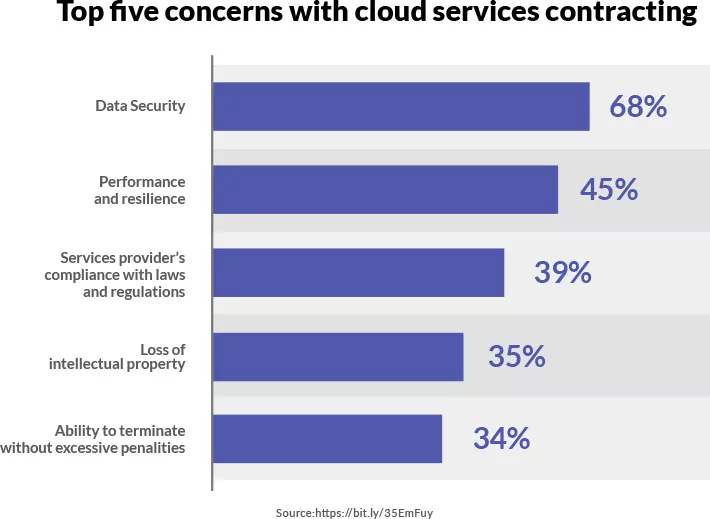
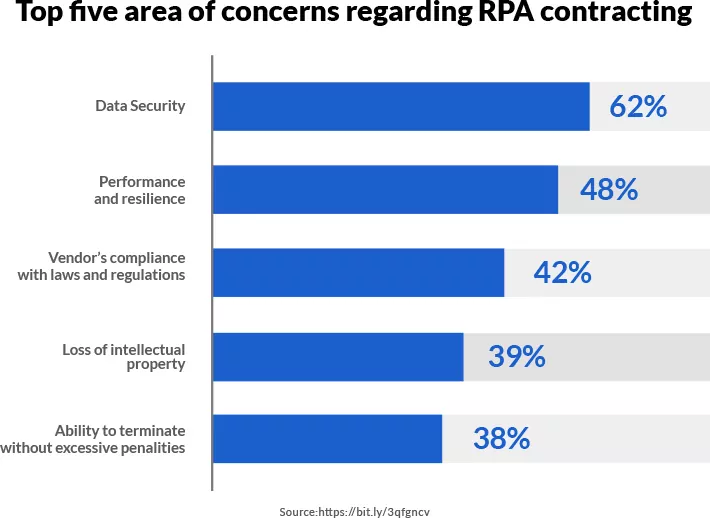
Global BPO Market Size and Reach
It is the two Asian territorial and population giants – India and China – that lead the way as prime outsourcing destinations, with the former outpacing the latter by a noticeable margin.
India has excellence in a range of BPO services and has enjoyed a position as the undisputed leader in the field for more than a decade. In terms of scale and skill level, India has demonstrated superiority. Not only do 69% of surveyed workers feel comfortable working six days a week, but the Indian government also has various incentives for those working in the IT sector .
According to the India Brand Equity Foundation (IBEF) report, the Indian IT industry will contribute 10% of the countries entire GDP by 2025 . There are currently over 5300 tech startups in the country, and the IT and BPO industries are estimated to grow from USD 191 billion in 2020 to USD 350 billion in 2025. India also has an impressive 55% of the market share in service sourcing, with 38% of the global BPO market.
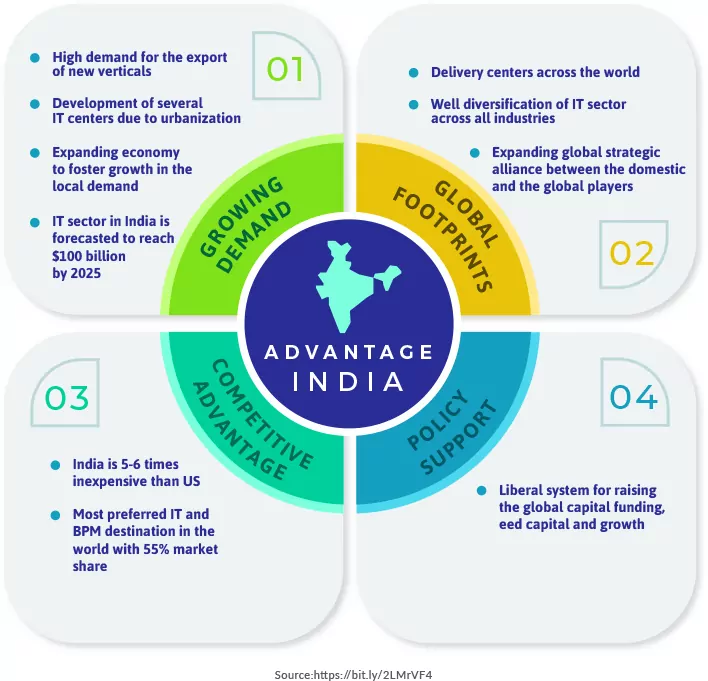
As technology grows into almost every aspect of operations, the line between IT and BPO is blurring. Service providers are beginning to offer bundled, specialized services that understand the centrality of technology on other sector domains and specialties.
China occupies the second position behind India in terms of the quality of the BPO market, is increasingly becoming more service-oriented. Government support is gaining for analytics and IT work. However, China is already becoming less competitive, as rising wages are affecting price arbitrage. The majority of customers of Chinese BPO services are domestic.
Somewhat surprisingly, owing to its small labor pool, Malaysia competes in the third-place spot against nearby India and the Philippines. It has the advantage of a politically stable, multilingual environment and reasonable rates.
Emerging Market Trends
BPO services emerged as an effort to reduce labor costs but have now become an industry in its own right - one that is increasingly adapting and innovating to improve the quality and comprehensiveness of the services offered. Clients are increasingly able to find sector-specific specialists to meet even the most niche need. Corporate clients have come to expect that BPO service providers will be able to offer analytics and big data services, in addition to traditional services.
To remain competitive, BPO service providers will, in the coming years, have to broaden their service offerings by hiring sector-specific employees, gaining intellectual property, taking advantage of automation, and building a global network.
Business process improvement (BPI) is a trend to watch as it is expected to play a central role in the growth of BPO services in the coming years. BPO vendors must always be working to improve the quality and efficiency of their services.
Like every other business, they will have to increasingly use social media to target both talent and clients strategically. They will have to reckon with increasing security fears and likely move to a private cloud model rather than the less expensive public cloud. Using new platforms will allow BPO’s to help their clients gain unique advantages by offering them advancement in automation, security, and effectiveness .
Automation platforms are benefitting from advances in cognitive computing. Machines are increasingly able to understand, learn, communicate, delegate, and problem solve. Robotic process automation (RPA) is the convergence of low-cost, easy-to-implement process automation, leveraged by machine learning, data analytics, and cognitive innovations.
It represents a new species of digital labor that can be applied to many tasks currently performed by human labor. Even so, over 75% of the 1500 surveyed US workers don’t feel that they’re at risk of losing their jobs to machines . The positions listed as most likely to give way to RPA include:
- Organizing and filing
- Scheduling tasks
- Data monitoring
- Data entering and spreadsheets
- Follow up emails and confirmation calls
- Basic customer service
The future of work is very different from the past, or even the present. Because of the intersection of technology with education, economies are poised to take advantage of emerging trends. Many jobs will be delegated to robotics, but in parallel, many jobs will be generated in creative and curating activities. Demand for creative services will grow as barriers to entry will continue to be diminished. For this class of jobs, robots will remain poor substitutes .
Robotic Process Automation has the potential to impact every single one of the functions described by BPO services. Although the technology is still young, it’s developing rapidly, with the global RPA market expected to reach a CAGR of 40.6% by 2027 .
The number of jobs delegated to robots will most certainly increase as the technology becomes more sophisticated. The BPO industry will likely react by changing its business model to adopt RPA as a core capability. Though most BPO providers are currently resistant to RPA, the threat it poses will have to be addressed sooner rather than later.
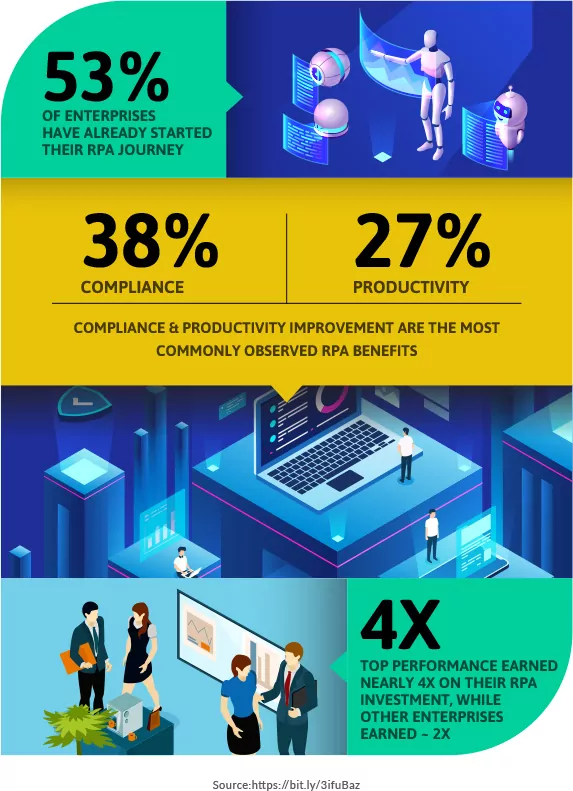
The BPO sector will also, at some stage, have to confront the possibility that large companies will adopt a DIY approach by bringing automation in-house. At the same time, third parties will be retained only in a consultative way. As software and automation technology becomes more accessible, the advantage that BPO providers currently have to reduce labor costs by up to 70% will be eroded by automating business processes in house .
However, the argument against automation remains that there are jobs that robots are not capable of performing. Empathy, creativity, judgment, or critical thinking—are required for many jobs, and as such, these types of jobs will never be threatened by widespread automation .
Industry Growth Potential and Projections
According to Grand View Research, the global market for BPO is projected to reach USD 405.6 billion by 2027, driven by the mounting pressure among companies to rationalize costs, improve operational performance and increase customer satisfaction .
As stated in the recent Global Data report, the US represents the largest market worldwide, with USD 96.1 billion in 2018 and estimated USD 152.5 by 2023, outpacing Asia-Pacific in both overall cost and growth rate . India still outcompetes as a lucrative destination for BPO services. Meanwhile, the Philippines has emerged as a strong competitor.
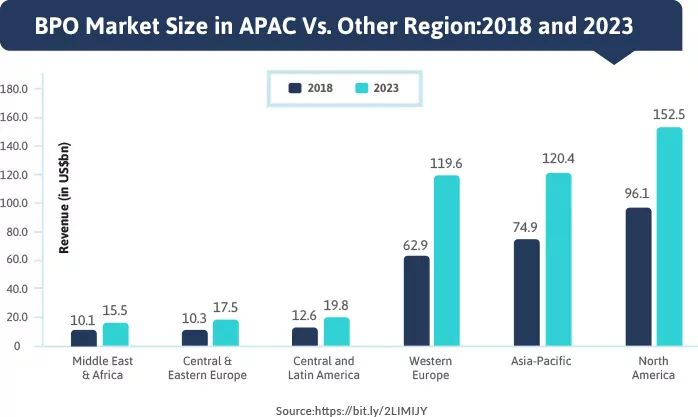
“The business challenges over the next decade are going to be very different than anything we’ve seen so far and the companies that weave a powerful network of global partners through outsourcing will be the winners.” - Michael Corbett, Chairman, International Association of Outsourcing Professionals (IAOP)
The rapidly changing business environment, and the external factors such as globalization, technological shifts, economic meltdowns, affecting business in various ways, companies are more inclined towards outsourcing as their strategic business models.
BackOffice Pro – The back-office partner of the global organizations
BackOffice Pro, a pioneer outsourcing company in India, provides business process outsourcing for various business requirements. We conduct a thorough evaluation of the clients’ requirements and devise strategic back-office support with flexible full-time equivalents (FTE) engagement models. With a decade of functioning as a business outsourcing, BackOffice Pro plays a key role in reducing cost, increasing productivity and efficiency while optimizing the allocation of resources for the clients’ operations.
Contact us to know more about our services and the outsourcing process at BackOffice Pro.